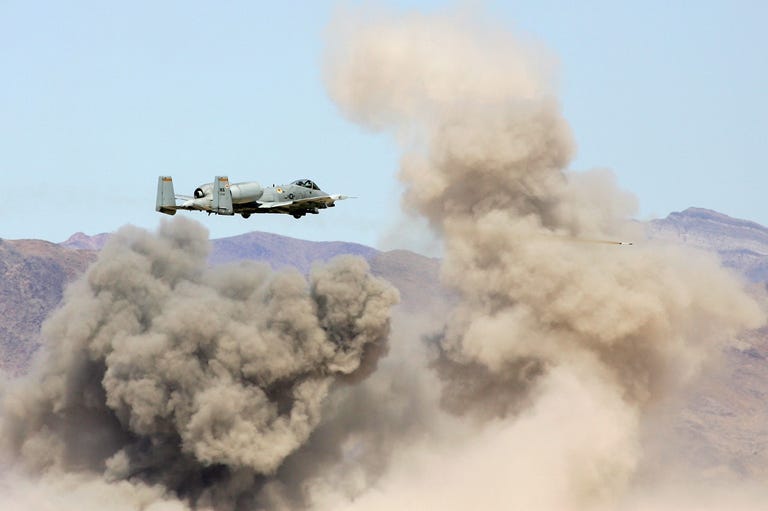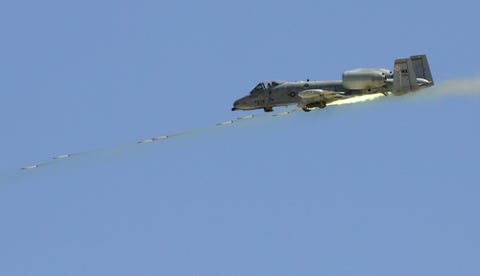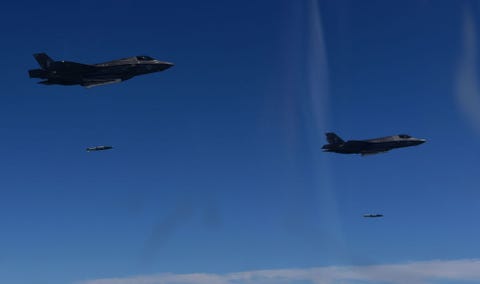By Kyle Mizokami
 The U.S. Air Force’s eagerly anticipated flyoff between the A-10 Warthog and F-35 Joint Strike Fighter has begun. The eagerly awaited competition, which pits the two planes against one another to determine which is the better close air support platform, began last week and wraps up tomorrow, July 12th. Critics charge that the Air Force is not only hiding the exercises from the public but is also heavily skewing the testing to ensure that the new F-35 is presented in the best possible light.
The U.S. Air Force’s eagerly anticipated flyoff between the A-10 Warthog and F-35 Joint Strike Fighter has begun. The eagerly awaited competition, which pits the two planes against one another to determine which is the better close air support platform, began last week and wraps up tomorrow, July 12th. Critics charge that the Air Force is not only hiding the exercises from the public but is also heavily skewing the testing to ensure that the new F-35 is presented in the best possible light.
The F-35A Joint Strike Fighter, the Air Force’s version of the controversial jet, is designed to replace the F-16 Viper fighter in the service’s vast fleet of combat jets. That’s not surprising, as both are single-seat fighter-bombers. What has always raised eyebrows, however, is the Air Force’s contention that the F-35A would replace the A-10 Warthog in close air support duties. The close air support mission involves flying in direct support of friendly ground troops, serving as a form of flying artillery, and killing enemy targets on the front lines.

The F-35A was designed as a stealthy killer against both air and ground targets, using its combination of stealth, sensors, and network-enhanced situational awareness to thrive on modern battlefields. It was not designed to do many things traditionally needed of a close air support (CAS) aircraft: carry lots of bombs, missiles, and rockets, have a large and powerful gun, the ability to loiter low and slow over or near the battlefield, and remain on station for long periods of time. These are all things that the A-10, the first Air Force aircraft purpose-built to provide close air support, excels at. The A-10 is very good at its job, something proved time and time again in war after war, from the 1991 liberation of Kuwait to ongoing fights in Syria and Afghanistan.
The 2017 National Defense Authorization act, better known as the U.S. defense budget, included language mandating a flyoff between the two planes to determine whether or not the F-35 has the chops to do the CAS mission after all. The aircraft will participate in a series of scenarios simulating frontline air strikes, evacuation of downed pilots, and the ability of pilots to act as forward air controllers for other planes. The event is already drawing accusations it’s heavily slanted in favor of the newer plane.
The Project on Government Oversight, a government watchdog organization, got a copy of the testing schedule and spoke to anonymous persons close to the event. POGO’s analysis: the flyoff is fundamentally flawed, hobbling the A-10’s strengths while working to obscure the F-35’s disadvantages. You can read the organization’s report here.

A-10 Warthog unleashing unguided 70mm rockets against a ground target.
POGO has a lot of complaints about the flyoff. Three years in the making, it lasts only one week and includes just four days of flying. The Air Force also outsourced test design to a defense contractor that works on and has a vested interest in the F-35 program. The tests were not conceived with input from A-10 pilots, Air Force Joint Terminal Attack Controllers, the airmen who call in air strikes and air support, or the Army and Marines. In other words the tests were drawn up without input from the very individuals that know the platform best and rely on it in combat, and were conceived by those who would rather see the A-10 go away.
The watchdog group further alleges that the testing schedule was designed to ignore the A-10’s well-known strengths. The schedule gives both aircraft the same amount of time and same number of sorties per day, despite the A-10’s ability to loiter longer over the battlefield, allowing the pilot to develop greater situational awareness of the situation on the ground, and the fact that the Warthog can fly many more sorites per day. The testing also hobbles one of the A-10’s most useful features, the GAU-8/A 30-millimeter Gatling gun, giving it just a third of a full load of ammunition.
At the same time, POGO argues that the testing is skewed to cover up the F-35’s flaws. The F-35 carries just a single guided bomb in one series of tests, meant to increase the airplane’s maneuverability at lower altitudes. The testing is also conducted against high visibility targets in clear terrain which the pretend enemy has made no effort to conceal. Critics have charged the faster-flying F-35 pilot, whose visibility from the cockpit is inferior to the A-10’s, would have a difficult time picking out targets on the ground—especially one hiding among buildings, behind trees, and in rough terrain.
The organization also believes the testing is too limited in scope, too short in duration and suffers from flawed methology. All of the testing is being conducted in good weather in the deserts of the American southwest, and not, for example, in the forests of Michigan in the rain. Four days of flying can’t hope to settle the matter of which aircraft is better—but is enough time to construct an argument to justify preexisting beliefs. Finally, POGO claims that the “absence of specialized testing equipment” to determine each aircraft’s success or failure “invites the use of highly biased, speculative figures to favor a predetermined outcome.”

U.S. Marine Corps F-35Bs drop bombs on the Pilsung bombing range, South Korea, 2017.
Dan Grazier, author of the POGO report, told Popular Mechanics, "The way in which the Air Force went about this process is shameful. The primary stakeholders in the close air support debate, ground troops, were not consulted in this process at all. Instead, Air Force leaders pushed ahead with their pet notions regarding close air support that have no basis in the realities of ground combat. Even more shameful, they specifically designed these tests to produce their desired outcome. This is a clear demonstration that Air Force leaders are primarily concerned with buying more F-35s than they are in meeting the battlefield needs of the Army and Marine Corps."
The Air Force has yet to comment on the competition, or to make any sort of announcement about it at all. The manner with which the Air Force is conducting the flyoff will no doubt taint the argument about which aircraft is better suited for the CAS mission. That’s a shame, because the U.S. and its allies really need to know if the F-35 can do the job or not. If it needs help, such as improved sensors or weapons, we need to know and work to implement those improvements. If it can’t, we need a fair and honest assessment that it can’t—and plan to keep the A-10 around until we have a truly viable replacement.
No comments:
Post a Comment